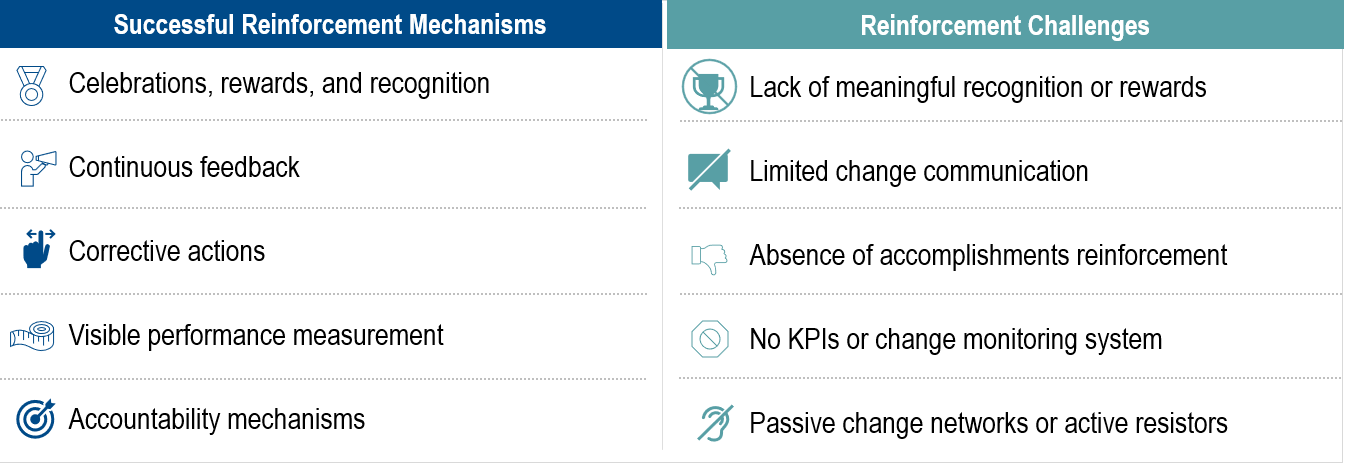If there’s anything as predictable as change, it’s resistance to change.
Serving as a counterweight to new ideas, processes, and technologies, detractors of change must be understood and planned for upfront.
No transformation large or small can fully avoid the spectrum of discontent that often accompanies change, from the quiet ambivalence of scarcely impacted employees to the hardline naysayers who feel they have much to lose should change take hold.
Change leaders can overcome these worries by ensuring the change management project plan appropriately includes critical communication, assurance, and reinforcement at all stages of the transformation and throughout all levels of the company.
Below are numerous ways the core change management team can address and overcome change fears.
1. Openly Engage
The key to managing complex change amid so many different personality types and perspectives is to address issues head-on. Don’t shy away from talking to people about why they’re resistant to change.
Through open, honest dialogue, change leaders can surface rumors, festering worries, hesitation, and even untruths about the change process. In some cases, an employee might not yet know enough about a transformation to fully appreciate its upsides. On the other hand, an employee might ultimately be fearful for their job security when changes like new policies, technology, or processes are implemented that impact them.
Engaging with resistors can be accomplished via:
- Freeform discussions one-on-one or in small group settings.
- Feedback sessions at various stages of a change implementation.
- Larger surveys to detect patterns and trends in the resistance data.
- Syncing with change leaders and people leaders to address lingering doubts from employees.
Often, leadership will need to employ multiple forums to engage with those resistant to change in order to truly understand and address concerns.
2. Listen
When communicating and executing change in the face of resistance, avoid trying to “win” every conversation. Especially in larger settings, it’s not appropriate to engage in a back-and-forth ad nauseum for the sake of changing someone’s mind.
Instead, simply ask why an employee is concerned and what they’d like their manager or the change leader to do about it.
If there appears to be a path forward that can suit all parties without derailing the larger change initiative, then it could be worthwhile to pursue. Conversely, depending on the size of the organization and the ubiquity of change resistance, it’s not always feasible to modify the change plan even slightly to suit every person’s demands. This will slow the project down, create scope creep, and might inevitably be futile.
The key is to create a space where challenges to change can be hashed out. Finding a better way through the change management process is always a desirable outcome, but an equally plausible outcome is to not adjust the original change management plan at all.
Teasing out these nuances is only possible through listening to staff.
3. Involve and Evolve
If you can’t beat ‘em, join ‘em isn’t the worst advice in the world.
In some respects, resistance to change exemplifies a passion for “getting this right,” a voice that’s willing to speak up, and a drive to be heard and included. Channeling this energy into the change project can work to all parties’ benefit.
For example, if a finance professional wants clarity on how a new RPA solution will impact their future career growth, task them with mapping out not only how their career can evolve in line with the new technology but also how the careers of staff in similar positions can as well. In this exercise, it empowers the employee to take action and to chart a future course with which they can be satisfied.
Shutting this employee down from the start would only create further dissatisfaction and resentment, which can lead to turnover and contagion throughout the organization.
During the initial planning of a change project, leaders can intentionally appoint historical resistors to lead certain aspects of the project. In this way, you bring them into the fold before they have the ability to stew in and spread their skepticism. Now that executing the change project is part of their job duty, they’re incentivized to buy-in, perform well, and champion the effort.

Strategically placing these advocates throughout areas of the business can help quash fears at the ground level and give a new face to the change effort. In other words, it’s not just corporate suits from HQ dictating change; it’s everyday staff with whom other personnel are familiar and may innately trust more.
4. Stay the Course
Change is constant, so there’s little benefit in allowing objections to fatally delay it. Whether it’s a process change, reorg, or digital transformation, there’s a certain momentum that fuels the progress of the change implementation.
Stopping change in its tracks can be incredibly damaging. It leads to potentially millions of dollars of rework once restarted, it undercuts the narrative that change was initially necessary, and it weakens employees’ trust in leadership. Using a proven project management framework like agile to guide the pace and execution of transformation can keep the process moving at all times.
Change shines a spotlight on leaders. If they can’t make timely decisions, stick with them, and see them through, employees take notice. What looks like uncertainty in the moment generates greater resistance down the road during any future attempts at change – leaders lost the narrative and they can’t get it back.
That’s why it’s imperative to stay the course. Iterate, execute, and move on. The ultimate success of the change effort can only be realized when it’s “done.” Too many companies never reach the finish line, though.
They start, pivot, stop, regroup, start, bring in another hire, ditch the project altogether, revive it with external support, and so on. This zig-zag path to success is surely the slowest, least-effective, and most expensive way to get there.
Stay the course.
For expert change management support on your transformation journey, contact CrossCountry Consulting.